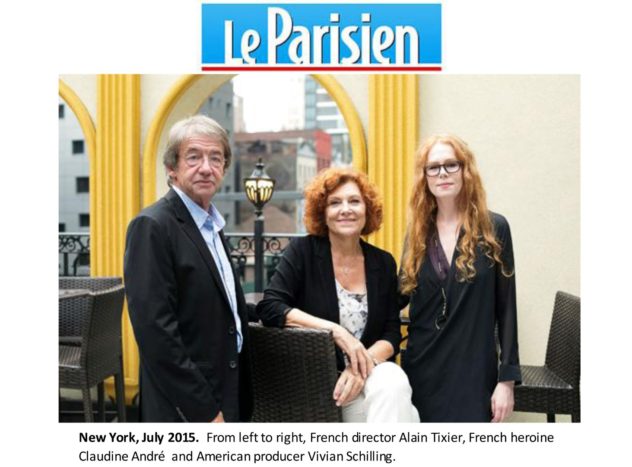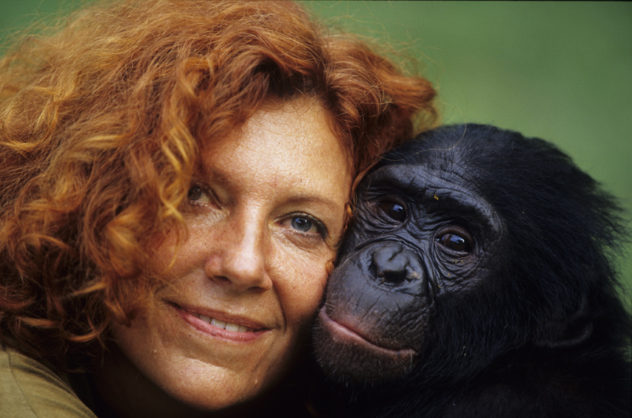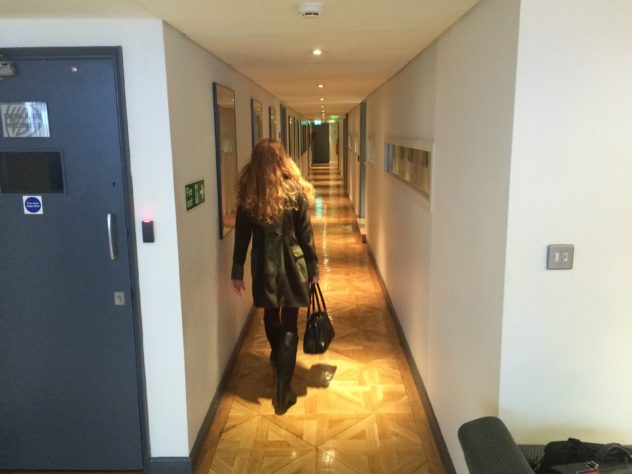… So touts the French publication “Le Parisien.”
“Bonobos: Back to the Wild” is now complete and my work on Alain Tixier’s acclaimed documentary is done. The New York premiere is over and the film’s U.S. theatrical release has commenced. I’ve removed the film’s title from my signature line and recycled a mountain of scripts and production notes. It’s time to move on to my other work, yet baby bonobos continue to romp through my dreams, cackling and giggling and pulling me back. I see them in my waking hours—peering at me in grocery stores and dancing rambunctiously in restaurants—furry little faces in place of toddlers’ who tug at their mothers’ pant legs. These remarkable creatures so much like humans share 98.7% of our genetic makeup and are closer to man than to gorillas. Yet unlike any other primate, including man, they have never been known to wage war or kill one of their own kind. They are the gentlest, least known, and the most endangered of the apes.
“Bonobos: Back to the Wild” chronicles the true story of conservationist Claudine André and Lola Ya Bonobo, the Congo sanctuary she founded for orphaned bonobos whose mothers have been killed by poachers. The film is about the bonds of mother and child, about loss and grief, about healing in the arms of a surrogate mother, growing in strength, bonding together, and being returned back to the wild. It’s about going home. It’s about hope and the promise that if you step up to the plate, it is still possible to make a difference in saving a species. Claudine André took a chance … Her first rescue was from a zoo in war torn Africa twenty years ago. In spite of naysayers who said the starving baby bonobo would not survive, she strapped him to her chest and kept him there until he was strong enough to be separated from her. She succeeded in not only keeping him alive, but in giving him back a life among his own. She has since rescued hundreds of orphans. She didn’t set out to be the world’s champion of bonobos, but she was open to the calling when it came. Needless to say, Claudine is the film’s heroine.

Filmmaking is nothing short of all-consuming. Whether you’re a grip, cameraman, seamstress, writer, director or producer, eventually we all turn into crazed zombies staring wide-eyed at our objective: the film’s completion and success. Having abandoned all sense of the outside world, of family and friends who wait patiently for the obsession to pass, we ultimately utter the same mantra—just one more all-nighter and our work will be done.
There are many reasons that keep us going, but for this film, the reasons have been tenfold. A percentage of all film proceeds go directly to Claudine André’s Lola Ya Bonobo sanctuary.
As a producer the job description can vary wildly, but always comes with an unshakable companion—the ever present gremlin at your ear whispering that the entire film will fall apart if you stop for a second.
I promised to check in after my last post about the film, but to my shock and dismay, it’s been half a year since then. In late April, I recorded Rebecca Hall in New York in between her wardrobe fittings and her flight to Georgia to portray the lead in the Spielberg film, BFG (“Big Friendly Giant”). Like Luke Evans, Rebecca took time away from a non-stop schedule to lend her voice to the film. And like Luke, Rebecca was an absolute dream. On her coveted day off from BFG, she recorded pickup lines for me without complaint. Next came the dialogue edit in Los Angeles, and the sound mix with my dear friend Kami Asgar who pushed aside his work on studio blockbusters because he believed in the bonobo cause. Then on to the credits, graphics and final mastering at a studio in Burbank. The film was complete only days before the press screening in New York. Claudine André flew in from the Congo, the film’s director Alain Tixier from Paris, Eric Parkinson and his staff from Hannover House (the film’s distributor) and an army of bonobo supporters from across the U.S descended on Midtown Manhattan.
The event was a success and there was finally a moment to breathe! I got to spend a few lovely days with Claudine and Alain, as well as to meet the remarkable U.S. team working for Lola Ya Bonobo.
Films are rarely created in a vacuum. It takes many. You learn as a filmmaker to be a team player. And like films, I have found the world of conservation much the same—a team of players impassioned by a common goal. Only this goal is not about pay, mere artistic expression, or box office success, it’s about man’s closest cousin who is critically in danger of disappearing from this planet just when mankind is beginning to take notice. Scientists, who are discovering the bonobo’s sophisticated use of sound to communicate, are striving to understand how these gentlest of apes who form matriarchal societies live in such harmony and peace.
Now that the film’s furry stars are venturing out on their own to meet U.S. movie goers, I’ve had the nervous jitters of a proud auntie. A barrage of “what if’s” dogging me. What if audiences don’t embrace them; what if they don’t look into their eyes and see what I see; what if they don’t fall madly in love with them and fight to protect them… what if… what if… Their well-being is tantamount to an obsession I seemed to have picked up along the way.
This past weekend, I attended a public showing of the film and fifteen minutes into it, my flutters suddenly stilled. I was hearing laughter, gasps, and at just the right moments, enraptured silence. To my delight, the audience of all ages was connecting to the bonobos who live an ocean away in the Congo.
After the film, I had children the size of the baby bonobos beaming up at me and telling me how much they loved the movie, while their parents stood proudly by. One bouncing girl told me how much fun she thought the bonobos were and that she wanted to see them again and again and again. My young bonobos had not left me, they were standing beside their admirers, equally bouncy and joyful. Their hands were entwined, their faces as hopeful and bright as their human counterparts. “Bonobos: Back to the Wild” is about family ties that transcend blood and even species. “To know is to love, and to love is to protect.” —an impassioned quote from Claudine André. I feel I now know the bonobos and will fight fiercely to protect them. My hope, and the hope of all who worked on this film, is that a whole generation of young will feel the same.
My beloved niece was at the New York screening and during the film she leaned over to me with tear-filled eyes and whispered, “This is a life changer.” I instantly imagined her at Lola with a trio of bonobos tugging at her and tumbling playfully around her. A “life changer.” Then I realized it was not about a complete redirection, but of a shift in her heart. An opening of a door to something beautiful. It’s certainly been one for me. As humans our years are numbered, but this is one I will never regret spending on the bonobos.
Thanks for listening to my musings.
Happy Almost Autumn and a big bonobo hug of thanks to all!
Click below to see the official trailer for BONOBOS: BACK TO THE WILD:

